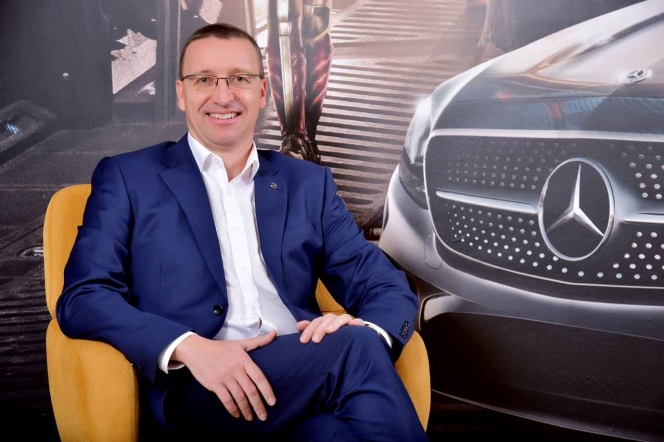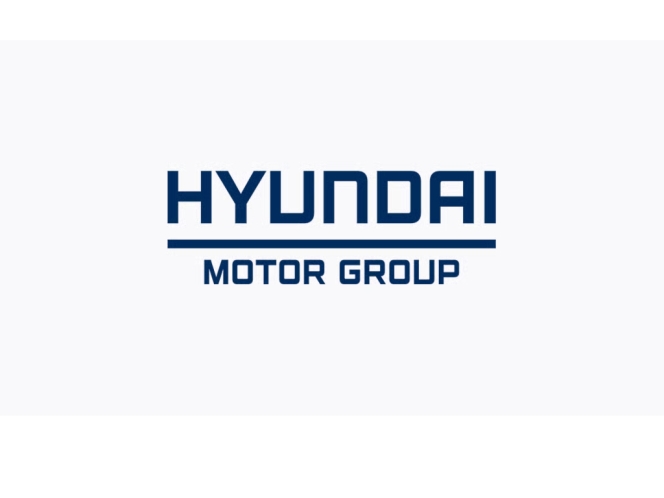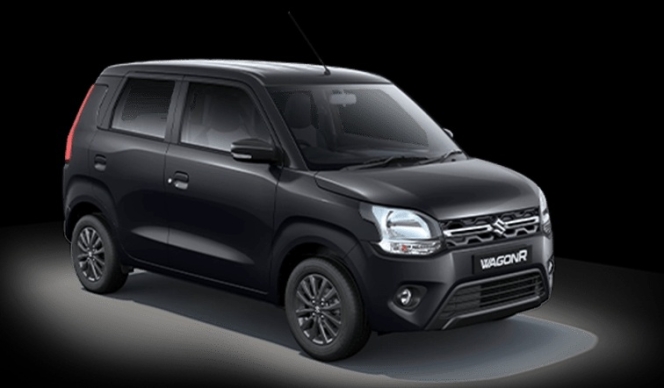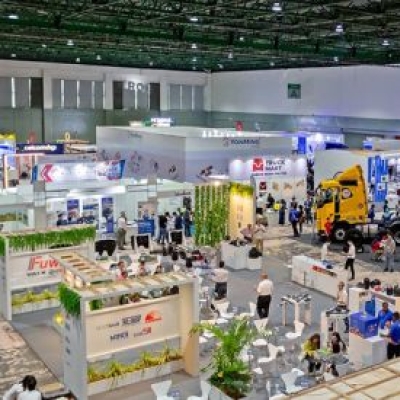In 2019 It Was Three-pointed Star For Mercedes-Benz India
- By 0
- December 21, 2021

By T Murrali
Crossing very significant milestones and achieving stellar sales performance made 2019 very special for Mercedes-Benz in India. The German car maker celebrated 25 years of operations of its local entity Mercedes-Benz India that began with a local assembly facility based at the Tata Motors (then TELCO) premises, and the tenth anniversary of the independent Mercedes-Benz plant in Pune.
 The year was also record-making for the company in defying the slowdown and selling more than 600 cars within a week during the festive season of 2019 bucking the automotive slowdown in the country since September 2018. This was over and above its outstanding sales performance a month ago when it delivered more than 200 cars in Maharashtra, especially in Mumbai, and Gujarat. It has also sold off the current GLE models about three months ahead of plan and has opened bookings for the upcoming new generation GLE scheduled to be launched before the Auto Expo 2020.
The year was also record-making for the company in defying the slowdown and selling more than 600 cars within a week during the festive season of 2019 bucking the automotive slowdown in the country since September 2018. This was over and above its outstanding sales performance a month ago when it delivered more than 200 cars in Maharashtra, especially in Mumbai, and Gujarat. It has also sold off the current GLE models about three months ahead of plan and has opened bookings for the upcoming new generation GLE scheduled to be launched before the Auto Expo 2020.
Mercedes-Benz India sold more than 10,500 units till October 2019. The year 2018 was the best ever as it sold 15,538 units with 1.4 percent growth over the previous year. It was the second year in a row that the company crossed sales of 15,000 units. In 2019 the company recorded its highest ever Q4 selling 3,871 units, thus registering a 3.3 percent y-o-y growth for Q4, and was able to achieve sales growth in a challenging market. Amidst strong macro-economic headwinds, Mercedes-Benz India sales volumes in Q4 also grew by 15.41 percent from Q3 2019 and the overall sales volume remained at 13,786 units from January-December 2019.
With its slogan ‘Best Never Rest’ the company carries forward the rich learning and experiences of the past 25 years to embark on a new journey towards reinventing itself for the future. As the inventors of automobile globally, Mercedes-Benz is highly confident of leading the luxury automotive industry which it pioneered in India, by not resting on past laurels and accolades but by striving to achieve excellence in the future.
The company’s factory in Pune makes nine different models including the sedans of the C-Class, E-Class, S-Class and CLA Coupé as well as Maybach S-Class and the SUVs GLA, GLC, GLE and GLS. The plant in India has been one of the first local assemblies of Mercedes-Benz to implement Virtual Reality technology, starting with the body shop training. As the implementation of Virtual Reality in the training process of the Indian plant has been a huge success, it is being implemented in other Mercedes-Benz assemblies around the world.
 The Managing Director and CEO of Mercedes-Benz India, Martin Schwenk, is very upbeat about the future course of the company. When told that he is the only car company CEO in India to have roaring sales, he told this publication that the festive season had been satisfactory for the company as it saw overwhelming response to its products from across markets. This has made him even more confident. He said his company’s plans would be well implemented, especially to launch new products; it was obvious that he was being both practical and optimistic.
The Managing Director and CEO of Mercedes-Benz India, Martin Schwenk, is very upbeat about the future course of the company. When told that he is the only car company CEO in India to have roaring sales, he told this publication that the festive season had been satisfactory for the company as it saw overwhelming response to its products from across markets. This has made him even more confident. He said his company’s plans would be well implemented, especially to launch new products; it was obvious that he was being both practical and optimistic.
During a recent interaction Schwenk said that the company works with its dealers to see how it can increase their profitability by looking into their inventory and stock levels, using its product offerings and ‘wish-box’ initiatives to raise the numbers. But about the order book position he said that “it is business as usual.”
On Growth Track
From the overall sentiment among customers and the availability of finance in the market Schwenk expects the industry to grow again. “I can see, when I follow numbers, that everyone is carefully and prudently managing the situation. Inventory management is taking up a big portion of every OEM’s activity. The BS-IV to BS-VI change will create some kind of distortion. Bigger the distortion, bigger will be the inventories at that point in time. Retail numbers being higher than wholesale makes me believe that the market is getting more receptive now. If there is good awareness among all, we can move forward as an industry. Turbulence will be there but it should not be a major irritation. From the second half of 2020 this transition period will be over and we would probably see a normal growth scenario. Until then the market might behave in a way that is hard to assess depending on inventory levels, pricing, discounting and whatever is necessary. I would expect some distortion where we won’t be able to easily ascertain the natural growth momentum. But with the efforts taken by Government and industry we could expect things coming back to normal soon.”
On the transition to BS-VI he said, “Our change from BS-IV to VI usually goes with new models. We have a strategy which is basically built on major model upgrades and new models. That’s why our transition started with the S-class (last year) where we had a new model with all the technology and features in it. For our brand I don’t expect any pre-or-post-buy triggered by BS replacement.”
The V-class Elite was launched in 90 countries. In India the company registered three-digit sales of its V-class and he is happy with the growing demand though the volumes are very low. “Every time we start something fresh we are keen to ensure it gets adequate returns. We try to upgrade based on what the customers tell us. The V-class does give an element of luxury; you will feel the difference when you sit in it. We are happy that we were able to open a segment where nobody had been before.”
The fact that the V-class is in 90 countries shows that it has developed well. This model, unlike its predecessors, is very much a passenger car, almost like an SUV. This has boosted sales in many markets. The global company has seen substantially higher numbers than expected, in most of the markets, he said.
The model launched in India is the same as the model Mercedes-Benz sells in other markets. It is totally imported but it is configured according to what a particular market needs and the prospective customer demand. “We have used all the feedback generated to create an offering that fits very well in the market here. The pricing of the upper-end V-class range goes up from INR 68 lakh to INR 1.1 crore. That is a wide span where you have the V-class for many different purposes in that series.”
Schwenk said the economic slowdown has definitely impacted his company with the entire industry slowing down by at least 20 percent. “We don’t have full transparency as not many manufacturers are disclosing their numbers. It’s not always easy for us to estimate what the market is doing but we believe the luxury market is down by 15 to 20 percent. However, we have maintained our market share of 40 percent in the luxury segment.”
On the customer preference for diesel vis-a-vis petrol, he said it has not triggered too much of a question. “What the customers expect is that we give them the latest technology in any engine and meet the highest standards available. Customers are not too concerned about whether we go for BS-IV or BS-VI. They are more bothered about the features in the car, the styling, design and, of course, the price. In the smaller segment we do get questions on the type of engine used, petrol or diesel. Our diesel share is unchanged in the larger SUVs and bigger sedans. Our diesel engines are highly efficient; they not only follow BS-VI norms but also are 20 percent more fuel efficient and better in CO2 emissions. If you look at the whole mix, diesel does come out as a clean fuel with the introduction of BS-VI.”
However, not all models are uniform in giving fuel efficiency; it varies from model to model. In the E-Class vehicles, engine fuel efficiency in diesel would be more by 15-20 percent. It meets all the BS-VI norms; NOX and carbon emissions are much reduced. It is very competitive with the petrol engine.
Electric Vehicles
About electric vehicle (EV) he said, “We would also develop EVs; we have already made slow entries into the market but I think we are still in the early phase of seeing what the right set-up is for the electric. From a framework and infrastructure perspective there is still some work to be done while from the customer demand angle it is not really hot. But the electric trend will certainly grow.”
“Our company has quite a few cars lined up at the global level; by 2022 we will have 10 pure electric vehicles worldwide. We would also have plug-in hybrids that we consider specifically for countries like India with about 20 models coming within the next two years. Electric will definitely have its space though we have not introduced any model in India. Based on our global portfolio and how the market develops here we would take a call on this. We are not in a rush because there should be the right momentum to get it on the road. Considering our overall strategy for 2019 we have decided to begin with connectivity as Indians are very much into their mobile devices. That’s why ‘Mercedes Me Connect’ was launched, which connects not only the new cars but also cars that go back to 2007,” Schwenk said. (MT)
Maruti Suzuki Celerio Scores 3 Star In Global NCAP Rating, Ciaz Gets 1 Star
- By MT Bureau
- December 22, 2025

Global NCAP, the automotive safety watchdog, has announced the latest results for its #SaferCarsForIndia campaign, with two models from Maruti Suzuki India, the country's largest passenger vehicle manufacturer, receiving mixed results.
The latest crash test result saw Global NCAP awarding the Maruti Suzuki Celerio a three-star rating for adult occupant protection following the inclusion of six airbags as standard. A previous version of the vehicle, equipped with two airbags, had received two stars for adult occupant safety and one star for child protection.
The technical evaluations of the six-airbag Celerio indicated protection levels ranging from good to marginal. The assessment noted that both the footwell and the bodyshell were unstable. Tests also showed exposure of children’s heads during front and side impacts.
On the other hand, the company’s popular sedan model the Maruti Suzuki Ciaz received a 1-star rating in the same assessment. The report for this model highlighted:
- The absence of side head protection.
- An unstable footwell and bodyshell.
- A lack of three-point seatbelts in all seating positions.
In contrast, Global NCAP reported that the new Dzire and Victoris models achieved five-star ratings.
Richard Woods, Chief Executive Officer of Global NCAP, said, “We are encouraged that Maruti Suzuki is committed to improving safety with five star performance for new models like the Dzire and Victoris, it remains disappointing however that some legacy models fall short.”
The results follow a commitment from Maruti Suzuki to increase safety standards across its future vehicle range.
CARS24 Appoints Divanshu Saxena As CBO Of Financial Services Arm
- By MT Bureau
- December 22, 2025

CARS24 has announced the promotion of Divanshu Saxena to Chief Business Officer (CBO) of its NBFC arm, CARS24 Financial Services.
In his new role, Saxena will oversee the strategy, growth and execution of the financial services division. His responsibilities include scaling lending operations, managing risk and maintaining profitability as the company develops its financial services platform.
Saxena previously managed the consumer financing business for LOANS24. During his tenure, the division recorded growth in finance penetration and contributions from non-retail lending. The company noted that his work focused on unit economics and portfolio quality.
Ruchit Agarwal, Co-Founder & Group CFO, CARS24, said, “Divanshu has played a pivotal role in building CARS24 Financial Services into a strong and institutionally sound business. His disciplined approach to growth, deep understanding of lending economics, and consistent execution have laid a solid foundation for scale. We are proud to elevate leaders from within, and as CBO, Divanshu will be central to shaping the next phase of growth for LOANS24.”
Before joining CARS24, Saxena served as a Project Leader at Boston Consulting Group (BCG) within the Financial Services and Industrial Goods practice. He is an alumnus of IIM Calcutta, where he graduated with a silver medal, and Shri Ram College of Commerce (SRCC), University of Delhi.
Divanshu Saxena said, “Building LOANS24 has been about creating a lending business that balances speed with discipline and growth with resilience. As CBO, my focus will be on scaling responsibly, strengthening our fundamentals, and continuing to build a financial services platform that earns long-term trust from customers and partners.”
Hyundai Motor Group Announces Executive Appointments For 2026
- By MT Bureau
- December 19, 2025

South Korean auto major Hyundai Motor Group has announced executive appointments effective from 1st January 2026. The changes focus on the transition to software-defined vehicles (SDV) and the development of manufacturing technology.
In total, 219 executives have been promoted across the Group, comprising four Presidents, 14 Executive Vice Presidents, 25 Senior Vice-Presidents and 176 Vice Presidents. Approximately 30 percent of these promotions are within R&D and technology sectors.
Manfred Harrer has been promoted to President and Head of the R&D Division. Since joining in 2024, Harrer has managed vehicle development. His new role focuses on SDV competitiveness and development projects.
Juncheul Jung is promoted to President. Jung currently manages the Manufacturing Solutions and Procurement Divisions. His remit involves the Group's Software-Defined Factory (SDF) approach and the integration of robotics into production systems.
Yeong Il Choi becomes Executive Vice President and Head of Domestic Production. Choi also takes the role of Chief Safety Officer (CSO) for production facilities in South Korea.
The company also announced revamping leadership positions in its regional business, where it has appointed Seung Kyu Yoon as President of Kia North America Operations, Bo-Ryong Lee as President and CEO of Hyundai Steel Operations, Gang Hyun Seo as Head of Corporate Planning, Affiliate Business Optimisation, Sungwon Jee as Executive Vice-President, Hyundai Brand Marketing and Yongseok Shin as Executive Vice-President of HMG Business Intelligence Institute.
Hyundai Motor Group has internalised technologies including the 'Pleos Connect' infotainment system and 'Atria AI' for autonomous driving. Appointments in engineering include Jeonghun Seo in Battery Engineering and Duckhwan Kim in Hydrogen and Fuel Cell Engineering.
Jaehoon Chang, Vice Chair, continues to oversee the direction for mobility, hydrogen energy and robotics. Within the financial sector, Chang Hyun Cho (Hyundai Card) and Si Woo Jeon (Hyundai Commercial) have been promoted to Executive Vice-President.
"The appointments are intended to strengthen organisational resilience and expand the leadership pipeline across functions. In addition, the appointments reflect the Group’s commitment to turning global uncertainties into opportunities for renewal and growth. It will continue to advance bold leadership transformation and secure strong competitiveness in the SDV era," the company said.
Maruti Suzuki India’s WagonR Surpasses 3.5 Million Units Production Milestone
- By MT Bureau
- December 18, 2025

Maruti Suzuki India has attained a production milestone of 3.5 million units for the popular hatchback the WagonR.
The model, which spans three generations, was first launched in India in December 1999 and is currently manufactured at the company's facilities in Gurgaon and Manesar, Haryana.
The WagonR joins the Alto and Swift as models within the Maruti Suzuki portfolio to reach this volume. Globally, the Suzuki WagonR was first introduced in Japan in September 1993 and is now sold in over 75 countries. In August 2025, the model reached 100 million units in cumulative global sales.
The current WagonR is built on the fifth-generation Heartect platform. Standard safety features include six airbags, Anti-lock Braking System (ABS) with Electronic Brakeforce Distribution (EBD) and Electronic Stability Program (ESP).
On the inside, it comes with a 7-inch touchscreen infotainment system. Connectivity via Apple CarPlay and Android Auto. Bluetooth and voice command functionality.
The vehicle has been the highest-selling car in India for the previous four financial years.
Hisashi Takeuchi, Managing Director & CEO, Maruti Suzuki India, said, “This achievement is not just a production milestone, but reflects the enduring love and confidence that generations of customers have shown towards brand WagonR. It is rare for a vehicle to receive such acceptance even after 25 years since its launch. The WagonR kept evolving with the introduction of new technology and features over time, while retaining its original DNA. The WagonR has been highly appreciated for aspects like its iconic tall-boy design, spacious interiors and fuel efficiency, which aptly reflect our customers’ needs and expectations. We are deeply grateful for their continued support and remain committed to providing ‘Joy of Mobility’ for generations to come.”






Comments (0)
ADD COMMENT